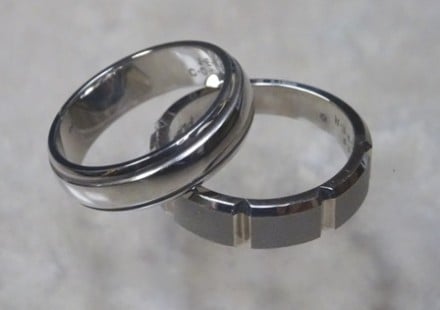
Contemporary palladium metalwork
Palladium is not as new to the jewelry game as many people might think. When platinum was declared a “strategic government resource” at the onset of World War II, palladium was brought to bear as its replacement in white gold alloys. That practice is still common. In fact, palladium white gold is the European standard, where the use of nickel alloys is severely restricted because of increasing reports of contact allergies to nickel.
High-purity palladium alloys for jewelry-making, however, are relatively new to the market, making their appearance in only the last twenty years at most. Palladium is a member of the platinum family, thus it is naturally a white metal. However, palladium is not a simple switch-out with platinum; yet neither is it superior to white gold alloys just because it is pure white. Palladium has its own unique place in the jewelry world because it has its own unique properties.
In pure form, palladium is whiter than platinum, but that is not the case with jewelry alloys.
Here’s why: platinum alloys vary in their fill-content, but they are typically alloyed with another pure white metal from the platinum family: iridium. Palladium alloys, the most common of which is referred to as 950 Palladium, is most often alloyed with ruthenium. Ruthenium is another member of the platinum family, but it is naturally a darker gray, which makes 950 Palladium have a slightly darker cast to it than most platinum alloys. But if you put a mirror-finish on both platinum and palladium, there is little appreciable difference in color. It only becomes noticeable as the polish wears into a satin finish.
Palladium, like platinum, is very inert, making it a hypoallergenic alternative to white gold alloys with nickel in them. Like gold and platinum, contact allergies to palladium do exist, but again: they are rare and often not as severe as nickel contact allergies. That’s one of several good reasons palladium has replaced nickel as the bleaching agent in white gold alloys in Europe, and why I use palladium white gold in my custom work.
Palladium can be worked like platinum, and it’s great for securing stones because it is extremely ductile. It stays where you put it and does not require excessive pressure when setting stones. As a bench jeweler, believe me: that’s a wonderful thing. Also like platinum, palladium tends to bend before it breaks. White gold alloys, especially 14k, are harder, less ductile, and lack the tensile strength of the platinum family.
But now on to the things which set palladium apart from both gold and platinum. Palladium essentially represents an intermediate ground between 18k white gold and platinum. They are not interchangeable, for they each have their own best suited purposes, so certain aspects are better for certain jewelry designs.
Palladium does not have the eternality of platinum; not even close. Yet palladium does not wear away like gold does. 950 Palladium is not as hard as 14k white gold, and depending on the manufacturer, it can be comparable to 18k white gold, but annealing 18k gold can produce some substantially harder alloys.
Translation: palladium tends to furrow like platinum, although not quite as readily. It does not hold a high polish for as long as white gold, but it does not dull quite as quickly as platinum.
Palladium’s primary upside is its strength-to-weight ratio. Palladium is less dense than both gold and platinum, so a measure of palladium goes farther than an equal measure of either gold or platinum. A ring of the same proportions in platinum and palladium will require much less precious metal to make, which keeps cost down.
This combination of low weight and reasonably high durability also make it perfect for large, bold statement pieces in earrings and pendants where weight is a primary concern. Platinum is very dense, often making it impractical for earrings or large pendants.

Palladium rings
This backfires on palladium, however, when it comes to filigree and piercework where delicate details are the heart of the piece. Palladium’s lower hardness and higher ductility make it more prone to bending. Such techniques require more rigidity for their stability and survival, and this is where white gold alloys excel.
The other drawback to palladium is repair work. Although palladium shares many properties with platinum, it has some key reaction differences at the temperatures required to do some repair work, like sizing rings. It can be tough to find a jeweler with sufficient experience and know-how in dealing with palladium to do the job right, and if you find one, you may have to pay a little extra for the specialized work required. It probably won’t be as expensive as repairing platinum, but it will be more than white gold. Again: palladium is an interesting intermediate between the other two metals.
My jewelers have the experience and know-how to work on palladium, but you may not always be within convenient distance to utilize our services. Wherever you go to have your jewelry serviced, be sure to ask if the jeweler working on your ring is familiar with palladium.
Tags: custom jewelry, engagement rings, engraving, facets, metals, palladium, platinum jewelry, white gold